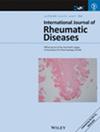Factors Associated With Hallux Valgus Progression in Patients With Rheumatoid Arthritis: Insights From Non-Weight-Bearing Radiographs in the KURAMA Cohort
Abstract
Objectives
This longitudinal study investigated the factors associated with hallux valgus (HV) progression in patients with rheumatoid arthritis (RA).
Methods
We included 316 patients with RA who underwent foot radiography in 2015 and more than four years later. The HV angle (HVA), first-second intermetatarsal angle (IMA), first-fifth intermetatarsal angle (M1/M5 angle), and calcaneal pitch (CP) angle were measured. Sesamoid position on a non-weight-bearing radiograph was divided into seven grades with reference to the Hardy classification. Factors of HV progression were examined.
Results
During a mean follow-up period of 6.1 years, HVA increased significantly. According to the grade of the sesamoid position, feet classified as grade VI or VII showed a greater change in HVA than those classified as below grade V. In feet below grade V, high disease activity, M1/M5 angle and right side were associated with the yearly increase > 1° in the HVA. For grades VI and VII, a large CP angle was correlated with greater annual changes in the HVA.
Conclusion
Sesamoid position relates with the increase in HVA in patients with RA. Disease activity, the existence of splay foot, and the right side are significant risk factors for an HVA increase in grades I to V.

 求助内容:
求助内容: 应助结果提醒方式:
应助结果提醒方式:


